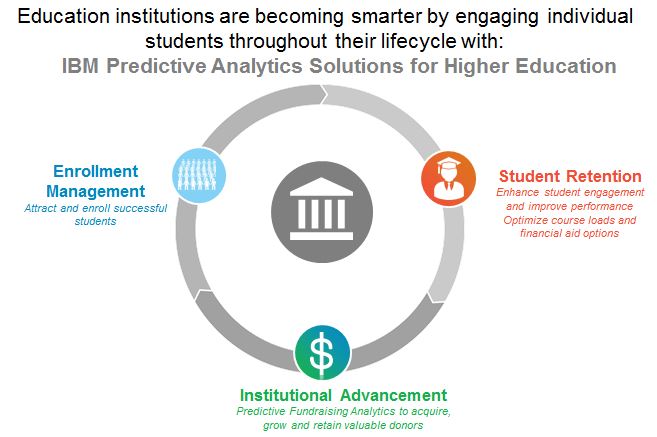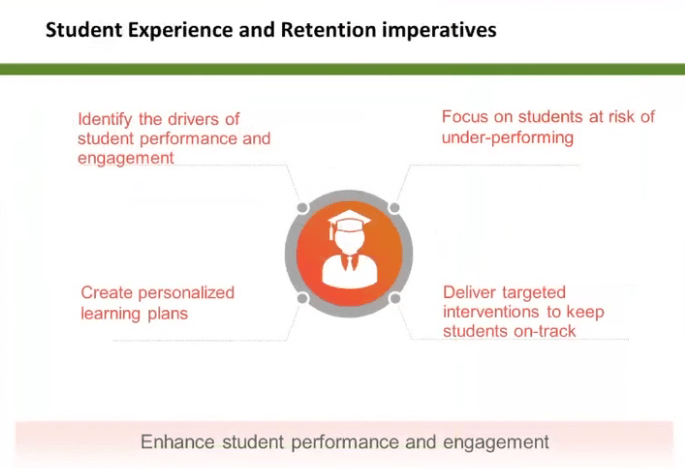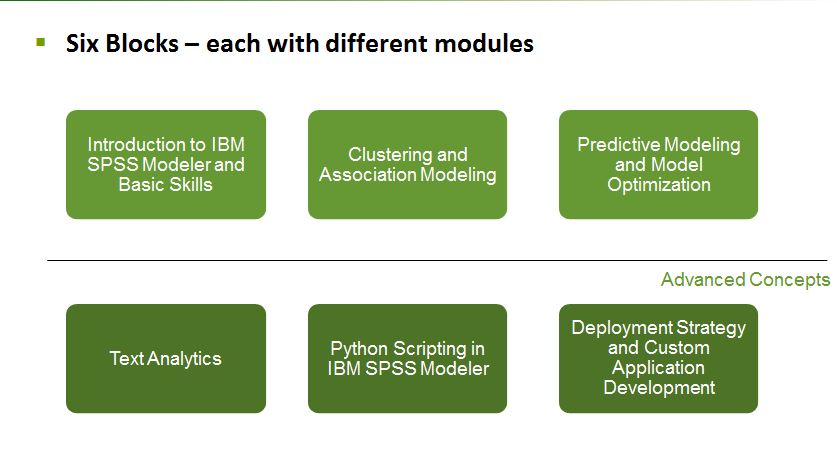Training and Workshops
Intermediate Data Preparation
Agenda
- Working with Date and String Fields
- Converting Long Files to Wide File: SetToFlag and Restructure Nodes
- Binning Methods
- Working with Sequence Data
- Global Fields
Skills Attained
The client will acquire a wider array of data preparation skills.
Value to Management
Many modeling procedures will require complex data manipulation. This module expands the client’s data preparation skills beyond basic data preparation, thereby enabling more complex data analysis.
Module
Clustering and Association Modeling
Agenda
Clustering Models
- K-Means
- Two-Step
- Kohonen
Association Models
- Apriori
- Carma
- Sequence
Skills Attained
The client will be able to select the appropriate clustering and association modeling techniques and optimize their settings for the most effective analysis.
Value to Management
BM SPSS Modeler provides several clustering techniques that can identify subjects with similar attributes (e.g. customers with similar preferences), and association techniques that can identify attributes frequently occurring together (e.g. bundles of products often purchased together).
Module
Predictive Modeling and Model Optimization
Agenda
Decision Trees/Rule Induction Models
- CHAID
- Classification & Regression Trees (C&RT)
- C5
- QUEST
Regression Models
- Linear
- Automatic Linear Modeling
- Logistic
- Cox (Survival Analysis)
- Time-Series Models
Machine Learning Models
- Neural Networks
- Support Vector Machine Models
Validating Models
- Partitioning
- Analysis Node
Automatic Modeling
- Auto Classifier
- Auto Numeric
- Auto Cluster
Skills Attained
The client will be able to take full advantage of the most commonly used modeling techniques by providing an in-depth understanding of them, and teaching how to select the appropriate techniques and optimize their settings for the most effective predictive analytics.
Value to Management
The depth of the predictive modeling techniques available in IBM SPSS Modeler distinguishes it from other software products such as spreadsheets and relational databases. The predictive modeling techniques covered in this module will become an integral part of an organization’s data mining process.
Module
Text Analytics
Agenda
- Text Mining and Linguistic Processing
- Viewing Text from Documents within Modeler
- Reading Text from Web Feeds
- Understanding the Extraction Process
- Editing Dictionaries
- Editing Advanced Resources
- Creating and Managing Libraries
- Automatic Categorization Techniques
- Manual Categorization Techniques
- Text Link Analysis
- Clustering
- Resource Templates
- Text Analytic Packages
- Using Text Analytics Results in Modeling Techniques
Skills Attained
The client will be able to implement a text analytics process that supports and extends data mining within an organization.
Value to Management
Text analytics extracts value from unstructured data by producing new flag fields that represent embedded topics and sentiments of interest. The new flag fields can also be used as either predictors or target fields in predictive analytics. This module develops the skills to control and improve the process of creating the new flag fields, and to reduce the amount of time required by re-using prior extractions.
Module
Python Scripting in IBM SPSS Modeler
Agenda
- Python Programming Basics
- Building Streams with Python
- Conditional Programming
- Loops
Skills Attained
Client will be able to create complex automated scripts for efficiently preparing data and repetitive modeling procedures
Value to Management
SPSS has embraced the Python language for automating and extending the capabilities of all of its products. Python scripting enables the client to automate tasks such as repeatedly executed steps with loops and conditionally executing steps in a stream.
Module
Custom Application Development, Deployment Strategy & Extensibility
Agenda
- Creating Custom Modeler Nodes
- C&DS Automation Functions
- Analytical Decision Management
- Deployment Architecture
- Technical Synergies w Rules and Optimization
Skills Attained
Client will gain and architectural perspective on deployment. Analysts will gain an understanding of the extensibility options available in advanced deployments and the technical nuances to extending a predictive platform with adjacent technologies including Cognos, CPLEX, and Rules
Value to Management
The SPSS platform enables the organization to scale best practices to maximize analyst efficiency. Capabilities including automation of analytic processes, custom nodes synergies with various other technologies including business intelligence, streaming data, rules and optimization give the Data Scientist more options for deployment of analytic results.
Advanced Analytics Platform Coaching and Mentoring
Over the course of many years in helping clients with projects and coaching emerging Centers of Excellence, we have created a 3 stage maturity model for the analytic professional interested in predictive analytics.
Our training maturity model helps your analysts move through three stages:
Basic Data Mining Practioner:
The analyst is familiar with the ways which predictive analytics provides value to an organization, the data mining process, and the basic usage of analytic tools for basic data manipulation and relationship exploration
Applied Data Mining Analyst:
The analyst will be able to conduct business requirements gathering functions in support of creation of a broader project plan. The analyst is competent in data manipulation and familiar with most, but not all of the modeling techniques available in the organization’s data mining toolset. The analyst will be able explain when to select appropriate clustering and association modeling techniques based on data profile and business problems, and will be able to optimize model performance using available settings.
Data Scientist:
The data scientist will be able to fully implement all phases of a predictive analytics project. The analyst will be able to comfortably converse with business sponsors on their goals and objectives for a predictive analytics project. The analyst will be able to manage all steps of the predictive development lifecycle including complex data transformation and preparation, modeling, and deployment to operational systems. The data scientist will be familiar with techniques including text analytics and programmatic customization.
Aviana has developed a training program to gradually build up analytics expertise to the appropriate level of the practitioner. Our trainers are all experienced data scientists with real world project experience. We specialize in SPSS Predictive Analytics – and can help your organization build skills with the tools to better deliver value in your analytics program.
Student retention is a critical factor for all colleges and universities. Gaining insight into the key factors that adversely affect student success helps schools intervene with students before they drop out. Underrepresented students – first-generation students, minorities, those facing economic hardships – are disproportionately impacted and are the least likely to proactively seek out help.
Aviana Global leverages the power of IBM’s predictive analytics solutions so colleges can rapidly identify, analyze and predict which students are most at risk. Colleges can then work with those students to find ways to keep them enrolled as well as close the achievement gap between underrepresented and non-underrepresented students.
In addition to improving student success, the same predictive analytics solution can be applied to a wide variety of areas across the college and university:
- Optimize marketing and outreach spend to attract good students
- Improve financial aid management
- Increase alumni and donor fundraising
- Maximize school revenue from sporting events, special events and student merchandise
This same software platform can even be used to analyze past security incidents so that security staff can be better allocated to high risk areas and improved lighting or monitoring can be installed to greatly increase campus safety.

Key First Steps to any Student Retention Strategy
Watch this video to learn about the key steps for your student retention analytics strategy
Training Tracks
Aviana offers the following three training tracks for instilling different levels of competency in data mining with the IBM SPSS Modeler software. These tracks are modular, so that completion of lower levels of training will apply to higher levels of training (i.e. the components of lower level tracks are the building blocks of higher level tracks). In addition, persons who are already familiar with the IBM SPSS Modeler software and some aspects of data mining could select only the advanced components of a high level track.
Our training program reflects the industry standard CRISP-DM methodology which includes Business Understanding, Data Understanding, Data Preparation, Modeling, Evaluation, and Deployment.
Upon completion of the entire Aviana curriculum, the Data Scientist will be able to fully implement all phases of the Cross-Industry Process for Data Mining (CRISP-DM) in his or her organization. In addition to gaining skills in IBM SPSS Modeler software, the Data Scientist will acquire the following skills:
- Ability to establish data mining objectives that will clearly benefit the sponsoring organization
- Awareness of the full array of reports available in Modeler for describing an organization’s data and assessing its quality
- Ability to complete complex manipulation of an organization’s data for the purposes of preparing the data for analysis
- In-depth understanding of the many modeling techniques available in Modeler in order to select the appropriate techniques and optimize their settings
- Ability to evaluate the data mining process and to identify the opportunities for improvement
- Ability to deploy modeling results by applying findings obtained from an organization’s historical data to new cases
- Ability to automate data preparation, analysis, and deployment with the Python programming language
In addition to acquisition of these skills, a fully trained Data Scientist will also explore advanced predictive analytics concepts including natural language processing, programmatic scripting, and custom application development
Planning Analytics for Excel (Pax) Training
Whether you have never even seen the interface for PAX, or whether you are an experienced report writer who is looking to maximize your skill set to include the latest best practices, Aviana has a training curriculum to fit your needs. Often there are newer members of the reporting team who could use an introduction course or a refresher course. Reach out to one of our training consultants and we can design a course that fits your organization’s specific needs.
Planning Analytics for Excel (Pax) Training Overview:
- What’s new in Pax?
- Building Reports
- Lists
- Exploration Views
- Quick Reports
- Dynamic Reports
- Custom Reports
- Additional Pax concepts and best practices
Aviana provides a variety of delivery models to work with your training and workshop needs.
Custom Onsite Training
Tailored agenda for attendees with courseware which is custom developed to leverage your own data. This can help bridge the “gap” between the features and capabilities learned in classroom environment on fictitious data and how those concepts can be applied in a real-world environment.
Custom Online Training
This is the same customized approach as the onsite training, but delivered live via Skype. As with any training, the opportunity to learn in a classroom with an instructor is always best. If the online delivery method is preferred, our instructors will work with your team and provide truer-to-life training, leveraging your data to create real-world models.
Workshops
Our workshop courses are an ideal way for an organization to bring larger groups of people up to speed on the basics in a short time. No formal courseware is provided but instead the instructors will design an outline curriculum to be used and will guide a classroom through introductory concepts and exercises. If you’ve had churn in your group and would like a refresher course, our workshops might be the perfect way to start before choosing a more formal training approach.





